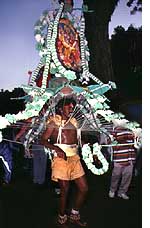 |
 |
 |
THAIPUSAM
~ Festival of Homage ~
 |
 |
 |
Thaipusam [see calendar] is celebrated widely by Hindus throughout the country and is one of the most colourful religious festivals in Malaysia. The chariot procession of the deity will leave the Sri Mahamariamman temple at 6pm on the eve of Thaipusam and will make its way back on the third day.
Elaborate and spectacular celebrations are held annually in Ipoh and other towns in Malaysia and it is usually a three day affair. On the first day, the idol of Lord Subramaniam is decorated and placed on a silver chariot and taken in a procession through the city to the Sri Subramaniam Temple in Gunong Cheroh. The chariot is pulled by a pair of bulls gaily decorated with flowers and garlands, accompanied by troops of dancers and musicians who beat and drum out lively tunes along the journey.
Stops are made along the way at the specially-erected roadside water-sheds called "thanni panthals", and at the various Hindu temples, for devotees to offer prayers and receive blessings from the deity. The roads are lined with stacks of coconuts which are broken in the path of the chariot procession as it weaves its way slowly through the streets, followed by a large crowd of devotees and spectators. The journey usually takes a whole day, starting from about six in the morning at the Sri Mahamariamman Temple at Buntong. The journey ends at the Sri Subramaniam Temple on Jalan Raja Musa Aziz around nine at night where idol is ensconced until the third day, when it is again taken on another procession back to the Sri Mahamariamman Temple.
On Thaipusam Day, devotees who wish to thank the deity for favours granted or to fulfil a vow, carry kavadis can be in any form, and are usually containers of milk or a large semi-circular structure lavishly decorated with peacock feathers, flowers and coloured paper, carried on the shoulders. Metal hooks or spikes attached to the kavadis are fastened onto the devotee's skin, or through it. Limes are sometimes attached to hooks which are pierced to their skin to ward off evil.
Devotees may also pierce the forehead, tongue or cheeks with small silver spikes called "vel", whic hare shaped like a spear. The piercing of the hooks and the spikes is usually done at the various temples early in the morning after certain prayers and rites are performed.
The devotees, who usually go into a trance after deep meditation, do not feel any pain and rarely bleed or scar. Usually, a period of fasting and praying, lasting from three to twenty one days - precedes the act.
From the various temples, the kavadi-bearers and other devotees head towards the hill temple, joining the main procession. The devotees walk the entire distance barefoot. They are accompanied by friends and relatives who sing, dance and chant "vel vel". Along the way, their feet are washed by the devotees manning the watershed.
Although this is strictly a religious ocassion, a carnival atmosphere prevails as vendors selling food, drinks and other items, conduct a roaring trade in the vicinity. The devotees add further colour to the whole affair by decking themselves in all their finery, with flashing jewellry, shimmering saris and resplendent dhoti.
It is quite spectacle and perhaps nowhere else except in Malaysia you can find Thaipusam celebrated with such fervour.


Breaking Coconuts
Coconuts are often used in Hindu temples. Devotees pay a small fee for prayers to be done in front of the deities of their choice. The name and astrology are said along with the prayer. And when this is done, in return, the devotee is given an "archana". This is the top half of a coconut with betel leaves, flowers, holy ash (vibuthi), red powder (kumkumam) and banana in it.